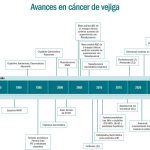
Data from the Cancer Genome Atlas (TCGA) Project have identified urothelial carcinoma as one of the tumor types with a higher level of genomic alterations. Different classifications have been established, in which urothelial carcinomas have been grouped into different molecular subtypes.
Each of them has been developed in different patient populations, using different genomic platforms. Despite the differences, each identifies molecular phenotypes that share some similarities. They represent a division into basal and luminal tumors, with different subclassifications.
In muscle-invasive urothelial carcinoma, the treatment of choice is radical cystectomy with lymphadenectomy. Neoadjuvant treatment is recommended cisplatin-based chemotherapy for patients with cT2/4N0M0 tumors, or as adjuvant treatment in patients with high risk factors (pT3/4 and/or lymph node involvement) after radical cystectomy.
Recently, for the first time, Immunotherapy has proven effective in the adjuvant setting. Nivolumab, an anti-PD-1, has demonstrated a positive impact on progression-free survival in patients with high risk factors after radical cystectomy (pT3/4 and/or lymph node involvement), who have not received neoadjuvant treatment, and not are candidates for (or reject) cisplatin treatment. Likewise, it has demonstrated its effectiveness in patients who, after neoadjuvant treatment, present high risk factors (ypT2/4 and/or lymph node involvement).
For the past 40 years, the treatment of choice for metastatic disease has been platinum-based chemotherapy. However, In the last year, immunotherapy and conjugated antibodies have marked a milestone in the management of urothelial carcinoma.
Between the 80s and 90s, cisplatin-based regimens (MVAC and gemcitabine/cisplatin) demonstrated increased survival compared to monotherapy and other combinations. Because the gemcitabine/cisplatin regimen has a more acceptable toxicity profile, it is the first-line treatment of choice for metastatic disease.
However, between the 40-50% of patients with metastatic disease are not eligible for cisplatin (‘unfit’ patients). In these cases, it can be replaced by carboplatin.
In 2020, maintenance treatment with avelumab (anti-PD-L1) in patients whose disease does not progress after first-line platinum-based chemotherapy prolongs overall survival. This represents a before and after in the treatment of advanced urothelial carcinoma, becoming a new standard of treatment.
More recently, in the last year, two studies have been presented that have demonstrated the benefit of combinations in the first line, replacing for the first time the classic regimens with cisplatin in this scenario.
The ChekMate 901 Study has shown that the combination of nivolumab with cisplatin/gemcitabine offers an overall survival benefit compared to chemotherapy alone. On the other hand, andIn the EV-302 study, the combination of enfortumab vedotin (conjugated antibody against nectin-4) and pembrolizumab (anti-PD-1) prolongs overall survival compared to a platinum-based chemotherapy regimen.
In the second and successive lines of treatment, in recent years, the range of options has also expanded significantly. Immunotherapy has demonstrated benefit in patients progressing to first-line platinum-based chemotherapy.
In 2021, the study EV-301 demonstrates that enfortumab vedotin offers an overall survival benefit in patients progressing to platinum-based chemotherapy and immunotherapy.
The study THOR has shown that erdafinitb (FGFR 1-4 inhibitor) increases the overall survival of patients with alterations in fibroblast growth factor (FGFR) tafter progression to platinum and immunotherapy.
All of these drugs “have been able to see the light of day thanks to clinical trials and the generous participation of patients in them. In these advances, there has been a very significant participation of Spanish centers. We keep believing that the best option, to the extent possible, is participation in clinical trials. But, above all, it is necessary that those advances that show significant benefits be incorporated equitably for all patientsand that access to the best treatment for their disease is universal,” they say from the SEOM.
“Small advances, taken together, are relevant. Hence our motto at SEOM: In Oncology, every advance is written in capital letters. These small advances, considered each one of them in isolation, could have been considered of little relevance, but accumulated together they have led to a notable change in the prognosis in many cases and the quality of life of many patients.”

Tobacco
Bladder cancer has an annual incidence in Spain of 22,097 cases, which makes it the tenth most common tumor, considering both sexes. However, its incidence is notably higher in men, in whom it occupies fourth place in frequency, with 18,247 new cases diagnosed per year, compared to 3,850 in women. Regarding mortality, it is the sixth cause of death from cancer in men, with 3,480 deaths per year.
The vast majority of tumors are diagnosed in localized stages, where treatments with curative intent can be offered. In advanced stages, the advances that have occurred in recent years have managed to improve patient survival.
The main known cause of bladder cancer is tobacco, to which more than 40% of all diagnosed cases are attributed.. Tobacco not only affects our respiratory tract through smoke; More than 60 carcinogenic products contained in cigarettes are absorbed and eliminated through urine, greatly affecting the cells of the wall of our urinary tract.
Some studies defend the relationship betweenand HPV infection (human papillomavirus) and bladder cancer. It is estimated that up to 17% of these tumors could be due in part to carrying high-risk HPV serotypes.
There are other risk factors, such as exposure to some industrial chemicals (certain metals, dyes and rubbers); exposure to cyclophosphamide, (a drug used in a type of chemotherapy); or schistosomiasis, an infection caused by a parasite that is usually found in Africa and certain regions of Latin America.
Althoughor it has been clearly demonstrated that the presence of a family history Bladder cancer increases the risk of developing the disease in other members of the same family, the diagnosis in patients under 60 years of age should be considered with special attention,” concludes the scientific society.

